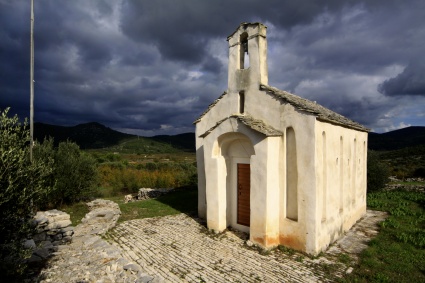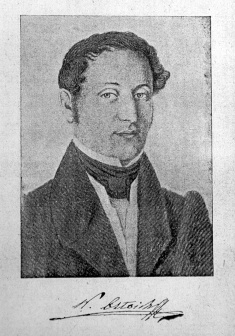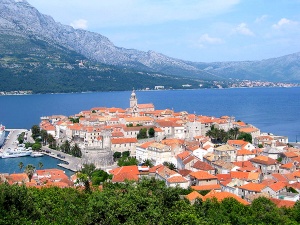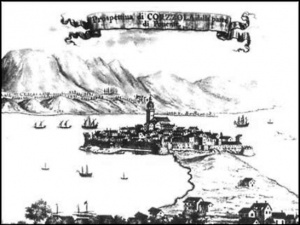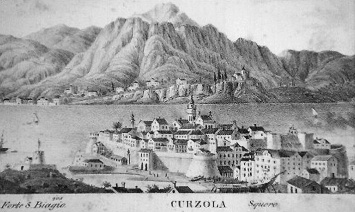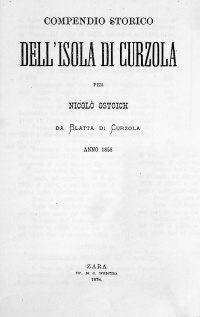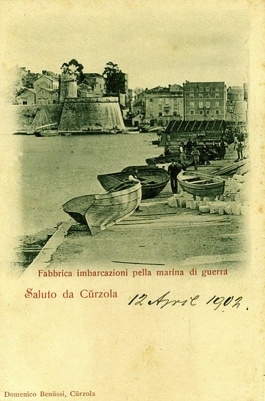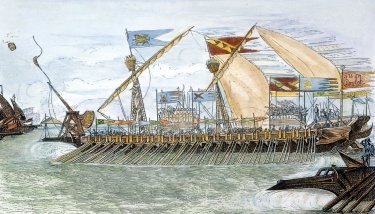History of Korcula - Historical Compendium of the Island of Korcula
- Historical Compendium of the Island of Korcula by Nikola Ostojic.[1]
Printing Company of G. Woditzka - Zadar/Zara 1858. (Originally written in Italian.)
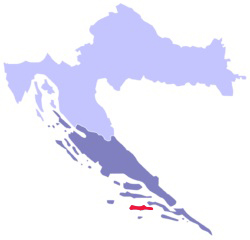
Chapter One - Origin and Events
Some fathers of history, based on Diti, [2] contemporary Cretan of the war of Troy, wish that Antenore as the first to land on the island and build a city. Because of the dark appearance of its woods called it Corcira Melaena .[3][4][5][6] Other followers of his position claim that they were not exiles of Ilius, but fugitives of Gnido. In turn the vernacularisation of Ditte (work of Cav) [7] Compagnoni, [8] stated that Antenore remained in Greece, but the said Aeneas, was the likely leader of the colony and founder of the City of Curzola, (Editors note: Korcula's old name was Curzola. In Croatian the c in Korcula is pronounced ch and is written "č".) [9] This theory was competing with the opinion of Darete, Phrygian and other contemporaries.
The truth of this claim, considering the mythological chronology of the grammatical Alexandrian Heratostene, would oblige us to go back to approximately 1184 BC, at the time in which according to the Bible, Gideon judged Israel: 126 years prior to David coming to the throne. But the historian, more traditional than anything else, cannot rely on these vague claims. Yet least of all when facing criticism. Ditte and Darete did not know how to support their historical theory. Whether Antenore or Aeneas was the leader, or Gnidi or the Trojans the colonists, the study of local antiquities arouses a belief that Korčula in ancient times was not some Greco-Phoenician post. Even though during this period there are inferences which are not at all unfounded, none are of a particular positive nature.
The mystery clears then when the Illyrians become powerful lords of the Adriatic. Their king Agron, asserting his authority on the other neighbouring islands also occupied Korčula, in 230 B.C.[10] On his death regaining its independence, the widow queen Teuta [11] took control of it again until Demetrius Fario, appointed as its prefect, surrendered it to the Romans together with Lesina (Hvar) his homeland. Whether Agron and Teuta had forcefully occupied the island with the use of arms, cannot be affirmed. The Alexandrian Appiano says no more than: "and once (they) conquered the island of Pharum (Hvar)" [12]; which makes us think it occurred due to combined dedication. Only in the times of Caesar Octavian Augustus (35 B.C.) does the name in the history of human events appear clear. It is known now for the first time, that the Curzolani (inhabitants of Korčula) tried to seal their reacquired freedom with their own blood. They resisted with anguished courage to the arms of the Triumvir who had come in person to conquer it. The punishment was equal to the resistance. The Alexandrian Appiano tells us of the severity of the punishment and the cause of the war:
But if Octavian in the repression caused it to be damaged, he didn’t consider it unworthy of his attention for its benefit; sending Roman colonists to it to direct it for better understanding and regulated habits, paving the way to a much greater cultivation and lessening the original coarseness. If the gravestones which are being unearthed among the ruins scattered across the island bear witness to the existence of the Roman colonies, they explain their purpose.
Korčula, from its origins to the present time, has been in existence for 3,038 years, and history classifies its political life in the following phases:
- Free with her own independence until the occupation by Agron, and then for very short intervals by Teuta, by the Romans until Octaviano Augustus; and then at the time of the Veneti [16] from 1180 to 1252, from 1254 to 1258, and from 1418 to 1420, on the whole.
- Subject to the Roman Emperors first from the west, then from the east, by Augustus to Heraclius until 642.
- Defeated and confederated by the Narantani (Neretva Slavic pirates)[17] from 642 to 999.
- Conquered by the Veneti under the management of the doge Pietro II Orseolo from 999 to 1100.
- Held by the Genoese from 1100 to 1129.
- Recaptured by Popone Zorzi, from the Veneto Region, and by the Republic subjected to this house from 1129 to 1180, from 1252 to 1254, and from 1258 until 1357.
- Possessed on behalf of the king of Hungary from 1257 and with brief interruptions of the Genoese until 1418.
- Devoting itself of its own accord to the Republic of Venice in 1420, and held by it with exemption from any tax until 1797.
- Surrendered with the Veneto State to Napoleon I of France, and united with the Kingdom of Italy from 1806 to 1807, and later from 1808 to 1813 annexed with Dalmatian to the Illyrian provinces.
- Taken and held by the Russians in 1808
- Taken from the French by the English and guarded for themselves from 1813 to 1815.
- Occupied by Austria, first by obligation from 1797 to 1806, later by Vienna Treaty from 1815 to the present 1858.
Chapter Two - Battles Sustained on the Island of Korcula
Protected by the Roman eagles, Korčula enjoyed peace and was well-off. Nor due to the change of events did she try to claim freedom; and as at first was faithful to Rome when the Empire divided she was ruled by Constantinople. But with the Caesar's loss of power the days of pain were nearing.
From a very old report discovered recently, that we don’t consider apocryphal, is noted how frightening the invasion of the Narentani (Neretva pirates) was for the island, and as to a certain king who, escaping the persecution of Narentani's fleet, built a fortress in Siralievaz, [18] in which with one hundred of his followers he had stationed himself, succeeded to gather the surrounding defence to himself. This king would have built other fortresses there: Maxima Autem, says the report,
He had the inhabitants of Korčula equip six prisons at his own expense, and thus also erect three shelters. Of all this there are obvious ruins to date.
Despite the relentless defence bravely sustained by the inhabitants, most from the Mattani in the fortress of Siralievaz, every effort was useless, the king was compelled to flee from the island; in fact he was almost taken by the Narentani in the sortie made from the western promontory, if he had not been freed on the part of the islanders. The reporter gives his name as Ristle and declares himself minister of the king, after his death which occurred elsewhere with royal brother Ottoniero, states that he returned to the island, where he had a sister desponsata Patron Spaho:
There was hard aggression committed to both towns of which the ruins can still be seen in Bradat and Potirna.[22] They were inhabited also by Roman families, as the gravestones and many other ancient pieces unearthed not so long ago bear witness.
A battle took place on the island around the year 829. Banished from the throne (the Curzolani) and from the State and Obeleiro and Beato Antenonj, or Antonaj, doges, one after the other of Venice. The Curzolani, already confederated of the Narentain, acknowledged friendship and partisan feelings. The doge Zuanne Partecipazio, being informed of these schemes, at the head of a strong army descended upon Korčula, which despite powerful resistance, saw many of his own killed and the prisoners hanged. The ex doge Beato Antenonio had his head cut off. (Editors note: Some sources state that Giovanni or Zuanne Participazio, killed Obelerio degli Antenori in Malamocco, near Venice. His severed head then was displayed to the people or that he died in Zadar. Another source states that he was buried with pomp in the Church of San Teodoro) [23]
A source from the Veneto Region stated that as a result of this fact Korčula and Veglia, where even the Antenonj had partisans, remained subject to those of the Veneto Region. This occurred for a brief period with regard to Korčula, the resulting reunion being tough between her and the Narentani, however the alliance lasted a short time. There is on the island a sunny valley called Dughipod, neighbouring the inundating field known Blatta (Blato), in which one could see various large masses of rocks, and among these the largest and widest, and the only one on the island, called Ducelova gomilla. From the previous matter and from the places, which embrace vast plains suited for manoeuvring an army in battle, it is probable that a battle occurred there and that under that impressive mass of rocks was buried the beheaded doge Beato Antenonio, and therefore to that the Slavic name of Ducelova gomilla, namely the doge’s partition wall.
The fourth battle was with the doge of the Veneto Region Pietro II Orseolo in 999, from which, having defeated the Narentani (Neretva Slavic pirates), their ally Korčula, was also conquered. Some historians note that the Curzolani, determined to oppose the advances of the doge, urged the Ragusani (Dubrovnik) and the Lesignani (Hvar) to form an alliance, but pre-empted by the sudden appearance of a large army in the Korčula Channel, which fruitlessly awaited on the nearby reef of S. Massimo.[24] Vulgo Massan, opted for negotiations for surrender, due to the fact that Korčula was forced to withstand alone. Of this fact Andrea Dandolo [25] writes:
The learned Marco Casotti with Lucio claim that the alliance of Korčula with the Narentani (Neretljani) worked to even make Venice their inland revenue, after the death of its doge Pietro Candiano in the battle of Pontamica, and that those of the Veneto Region were now avenging themselves of this by dismantling Korčula from the foundations.
The reports tell that the Venitians were distracted in the Holy Land undertaking and allowed the Genoese, in the year 1100, to occupy the island of Korčula and to keep it subjugated for some time. This subjection will not be followed with a fight, as the Curzolani with far greater powers fought to support their freedom, nor without shedding of blood would they be subjected.
Miroslav, Nemanja and Costantino
Miroslav, Stefan Nemanja [27] and Costantino, counts of Chelmo,[28] broadened with significant conquests the fatherly encroachers and possessed the territories of Narenta (Neretljani), Macarsca (Makarska) and Stagno (Ston). The counts wanted to conquer Ragusa (Dubrovnik) and to the detriment of Catholicism they also wanted to conquer nearby Korčula.[29] Therefore Constantine with a strong army, which amounted to some twenty thousand men, in 1181 landed in a faraway part of the city of Ragusa and began also to terrorise the island with fire and steel. But the Curzolani, gathering together ,[30] as Farlati [31] writes, took up the pursuit of their enemies, of which they killed many. Others were taken as prisoners, among which the said Constantino, who to obtain his freedom was compelled, together with his brothers, under oath to promise never again to make an attempt to take any step towards the independence of the Curzolani. With this resounding victory they honourably regained their freedom and preserved/protected the professed Catholic religion.
Zorzi House
By the end of the year 1129 Korčula was subjected to the Zorzi House (Republic of Venice) but due to various events regained it's independence. In 1252 Marsilio Zorzi succeeded in re-conquering it for Venice. The Curzolani suffered badly under his tyranny and after two years of his control dismissed him. Ruggero Zorzi a few years later with the help of Venice and Ragusa (Dubrovnik), amassed a strong arm of forces and arrived below the city calling on it to surrender. Not taking any notice of these threats, the Curzolani resolutely rejected the attack and tested the enemy inflecting lots of damage. They seized the banner from the invaders. The wounded Ruggero was obliged to give up and take cover within the island. A number of the inhabitants, allured by promises, acted as a support for him in order that he could return to the offensive against the city. After a strong crushing battle, Ruggero sacked and demolished the town. He placed Count Marsilio back in command. Merciful towards the defeated, the walls he rebuilt were more beautiful than before.
Giorgio Viario
In the year 1483 Federico of Aragon, son of Ferdinand king of Naples, was at war with the Venetians.[32] With Lissa (Vis) being destroyed and conquered a large army landed their troops with the aim of conquering Korčula. Giorgio Viario then ruled the island with the title of count for the republic of the Veneto region. He was a fearless and courageous man who had the city well armed. He positioned the few island fighters in appropriate sites and resolutely defended the town of Korčula. With the aid of these allies he repelled repeated assaults and destroyed the catapults thus turning the tide of the battle in favour of the defenders. His followers also fended off attacks by the other military artilleries employed by the Aragonese to demolish the walls and enter the city. Such was the courage of the Curzolani who for several days resisted this siege, and repelled the attacks. They struck down arrows and made a large number of aggressors fall under the walls.
To confuse the enemy, Count Viario envisaged the plan to have the bells ring suddenly. The Aragonese bewildered by the city bells ringing and of the near danger, left under the walls of the city more than 500 men and a large amount of war equipment. They retreated and fled on the high seas. This victory occurred on the 24th of August,the feast day of St. Bartholomew. A commemorative procession was devoted in thanksgiving that is customary in all parishes of the island on this all day feast. The prince and Senate of the Veneto Region later so appreciated the victory that they erected a memorial.
See also
- Original Direct Translation from Italian
- Korcula History, Romans & Venice
- Defence of Korcula
- Korcula Dialect
- Vallegrande Speak
- Korcula and Italian Wikipedia
Editor's Notes
Note A. Nikola Ostojic wrote: "Korčula in ancient times was not some Greco-Phoenician post".
A Greek colony was founded on Korčula.[34] Greek colonists formed a small colony on the island in the 4th or 3rd century B.C. Lumbarda Psephisma is a stone inscription which documented the event and was found on the island of Korčula, in modern-day Croatia. The Psephisma is from Lumbarda, (a small village on east end of Korčula) where it was discovered in 1877 by Bozo Krsinic (Ostojic wrote his book in 1858). The Greeks established a settlement on the basis of a prior agreement with the representatives of the local Illyrians who were Pil and his son Daz.
Quote from the Lumbarda Psephisma:
Note B. Nikola Ostojic wrote:"Defeated and confederated by the Narantani from 642 to 999."
The date stated by Ostojic of Korčula's being confederated by the Narantani has to be questioned. To this editor's knowledge there are no existing primary historical sources that actually described the event of Croatian Slavs invading and settling the island of Korcula in the middle ages. The Narantani, which are referred today mainly as Neretvani, were a nation of pirates. Firstly known as Arentanoi.[36] Modern scholarly research now puts the time of the invasion of the Slavic tribes in the Roman Dalmatia region to be much later.[37] Archaeological evidence found in the old Roman city of Salon and in particularly the artefacts found at the Old Croatian grave sites in Dalmatia (during recent excavations) seems to confirm this. The arrival and the main settlement of the Slavs by some has now been thought to be more in the region of the late 8th century or early 9th century.[38][39]
The term Slav was first used by the Byzantines (i.e. Procopius-Byzantine scholar, Jordanes- 6th century Roman bureaucrat) and was recorded in the 6th century (cia. 550) in Greek. Slavic tribes invaded the region of Roman Dalmatia in the early Middle Ages. Prior to the arrival of the Slavs, Roman Dalmatia was mainly inhabited by a Roman Latin-Illyrian population.
Encyclopaedia Britannica's (publ. 1911)
Article on Korčula from 1911:
Notes and References
- ^ Nikola Ostojic is from the town of Blato which is situated on the island of Korcula.
- ^ A Classified Catalogue of the Malta Garrison Library by Malta Garrison Library (p64)
- Ditte di Creta, e Darete Frigio. Delia Guerra Trojana. (Collana Greca. class. 12.)
- ^ Korcula: Latin: Corcyra Nigra - Black Corcyra. Italian-Curzola, Greek-Corcyra Melaina. The original Greek island name is Kórkyra (Κέρκυρα). In English the Greek island is called Cofu
- ^ Korcula is an island in the Adriatic Sea, in the Dubrovnik-Neretva County of Croatia. The island lies just off the Dalmatian coast.
- ^ Encyclopaedia Britannica (publ. 1911)
- ^ Encyclopædia Britannica. Encyclopædia Britannica Online. Encyclopædia Britannica, 2011.
- ^ Cavaliere = Knight (honorary title)/Ostojic's original historical source from 1858.
- ^ Dalmatia, literary sheet, 1st January 1846; No. 1/Ostojic's original historical source from 1858.
- ^ The Old-Slavic term for Korcula was Krkar.
- ^ In the original book the date was 250B.C. Latest historic research states 230 B.C. to be more accurate (Illyricum & Roman Politics 229 BC-AD 68 by Danijel Dzino)
- ^ Queen Teuta (Ancient Greek: Τεύτα) was an Illyrian queen of the Ardiaei tribe who reigned approximately from 229 BC to 227 BC.
- ^ Latin section: "Pharumque bello captum"
- ^ Melite is the island of Mljet. Mljet is an island in the Adriatic Sea, in the Dubrovnik-Neretva County of Croatia.
- ^ Corcyra is the island of Korčula
- ^ Latin section: "Divus Augustus deficientes Melitenses et Corcyrenses qui Insulas incolunt; ingenti belli mole superavit, quoniam maria classe praedebatur. Puberes ad unum caesi cetera multitudo sub corona venit"
- ^ People from the Veneto Region/Ostojic's original historical source from 1858.
- ^ When Ethnicity did not Matter in the Balkans: by John Van Antwerp Fine (p62)
- ^ Latin sections: "qui fugiens a persecution galearum Narentinorum construxit arcem in Siralievax"
- ^ Latin section:"arx fuit in domorio incolum quem locum appellant Bradat apud domum unius hominis probi, et sacnti quem incolae dicunt Sveti Visko"
- ^ Latin section: "in portu ad septentrionem montis sic dicti Gradinae ubi sistebant naves nostril regis clementissimi.....non longe maris interni Insulae aptus locus est ad debellandos piratas fortes Narentinos molestos valde"
- ^ Latin section: ".... domino domorij Sitinitiani (Sitnizza) pulcherimi agri in quo habebat tentorio et capiebat aves ... et inveni, continues, Narentinos depopulasse multa. Omnes mee vires sestebant in conspectioneagrorum atque navium ... nos non possumus prodire nullibi, nisi in fortes hostes incurramus."
- ^ Potirna is a village on the west end of the island of Korcula in Croatia.
- ^ "The doges of Venice" Chapte Two: Wooers of The Adiatic A.D. 809 to 960
- ^ also known as abbr. aka; (ref. plant, animal) common name./Ostojic's original historical source from 1858.
- ^ Andrea Dandolo (1306 – September 7, 1354) was elected the 54th doge of Venice in 1343, replacing Bartolomeo Gradenigo who died in late 1342.
- ^ Latin section: "Curzolae habitatores suis (of Orseolo) recusants parere jussionibus, valida manu acquisivit suaeque potestati subjugavit."
- ^ Stefan Nemanja (c. 1114 – 13 February 1199) was a 12th-century Serb royalty, heir to the Vukanović dynasty and Grand Prince of medieval Raška from 1166 to 1196. Nemanja was from Ribnica in Zeta, present day Podgorica which is the capital of Montenegro.
- ^ Nobles of Raška who ruled Chelmo (Zahumlje). Raška was a medieval principality created by Serbian Slavs (Costantino is referred to as Stracimir).
- ^ The Late Medieval Balkans: A Critical Survey from the Late Twelfth Century by John Van Antwerp Fine (p8)
- ^ Latin section: "cum se in unum conglobassent"
- ^ Daniele Farlati (22 February 1690 – 25 April 1773) was an ecclesiastical historian. Farlati was born in San Daniele del Friuli in present day Italy.
- ^ Canon Pietro Casola's Pilgrimage to Jerusalem in the Year 1494 by Pietro Casola - www.archive.org (Note 58 on p377)
- ^ Latin section: "Joannes Mocenigo Dei gratia Dux Venetiarum Sapientissimis, et Egregiis Viris Comiti, et Populo Curzolensi fidelibus Nostris clarissimi salutem, et gratiam Nostram."
- ^ An Inventory of Archaic and Classical Poleis: An Investigation Conducted by The Copenhagen Polis Centre for the Danish National Research Foundation by Mogens Herman Hansen,2005,Index
- ^ Hrcak Portal of scientific journals of Croatia: Lumbarda Psephisma, the Oldest Document about the Division of Land Parcels in Croatia from the Beginning of the 4th or 3rd Century BC by Miljenko Solaric & Nikola Solaic (University of Zagreb).
- ^ The Age of the Dromon: The Byzantine Navy ca. 500-1204 by John H. Pryor & Elizabeth Jeffreys (p67)
- ^ Becoming Slav, Becoming Croat: Identity Transformations in Post-Roman and Early Medieval Dalmatia by Danijel Dzino (p212).
- Danijel Dzino states that the 19 century theories of mass movements of people into the old Roman Province of Dalmatia are questionable. Modern Archaeological and Scholarly research seems to be saying that we are looking at much smaller groups of Slavs and Avars invading the region. The term Slav was first used by the Byzantines and was written in the 6th century in Greek (Σκλαβῖνοι-Sklabenoi). Later in Latin it was written Sclaveni. According to Danijel Dzino the term Slavs was first used by outside observers of the day to describe the newcomers. The Slavs used the term to describe themselves at a later stage. Thus began the construct identity of the new arrivals. Later the Slavic peoples started to identify themselves and separated (or were separated by others) into different groups.
- ^ Historians of this school of thought are D. Dzino, L.Margetic, Ancic, Rapanic and Sokol.
- ^ Note: The early sources must have reflected the raid activity of the Slavic tribes within Roman Dalmatia.
- ^ Encyclopaedia Britannica (publ. 1911)
External Links
- Photo link for a aerial view of Korcula Town
- Korcula Info
- Vela Luka-Mediterano
- Wikipedia: Lumbarda Psephisma
- Wikipedia: Battle of Curzola
